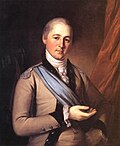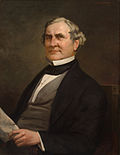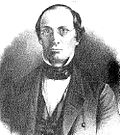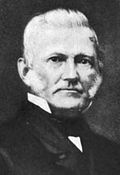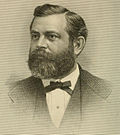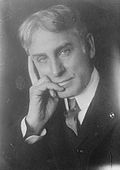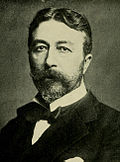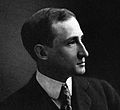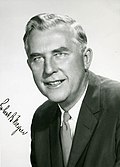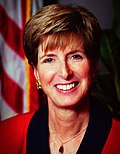Top Qs
Timeline
Chat
Perspective
List of governors of New Jersey
From Wikipedia, the free encyclopedia
Remove ads
The governor of New Jersey is the head of government of New Jersey and the commander-in-chief of the state's military forces. The governor has a duty to enforce state laws and the power to either approve or veto bills passed by the New Jersey Legislature, to convene the legislature, and to grant pardons, except in cases of treason or impeachment.[1]
The first New Jersey State Constitution, ratified in 1776, provided that a governor be elected annually by the state legislature, the members of which were selected by the several counties.[2] Under this constitution, the governor was president of the upper house of the legislature, then called the Legislative Council.[2] The 1844 constitution provided for a popular vote to elect the governor,[3] who no longer presided over the upper house of the legislature, now called the Senate. The 1844 constitution also lengthened the governor's term to three years, set to start on the third Tuesday in January following an election, and barred governors from succeeding themselves.[4] The 1947 constitution extended terms to four years, and limits governors from being elected to more than two consecutive terms, though they can run again after a third term has passed.[5] Joseph Bloomfield, Peter Dumont Vroom, Daniel Haines, Joel Parker, Leon Abbett, and Walter Evans Edge each served two non-consecutive stints as governor while A. Harry Moore served three non-consecutive stints. Foster McGowan Voorhees, James Fairman Fielder, and Richard Codey each served two non-consecutive stints, one as acting governor and one as official governor.
The 1776 constitution provided that the vice-president of the Legislative Council would act as governor (who was president of the council) should that office be vacant.[2] The 1844 constitution placed the president of the Senate first in the line of succession,[6] as did the subsequent 1947 constitution.[7] A constitutional amendment in 2006 created the office of lieutenant governor,[8] to be elected on the same ticket for the same term as the governor,[9] and if the office of governor is vacant, the lieutenant governor becomes governor.[10] This office was first filled in 2010.
There have been 56 official governors of New Jersey, 1 of whom was female, with several others acting as governor for a time.[a] In the official numbering, governors are counted only once each, and traditionally, only elected governors were included. However, legislation signed on January 10, 2006, allowed acting governors who had served at least 180 days to be considered full governors. The law was retroactive to January 1, 2001; it therefore changed the titles of Donald DiFrancesco and Richard Codey, affecting Jim McGreevey's numbering.[11] The first and longest-serving governor of New Jersey was William Livingston, who served from August 31, 1776, to July 25, 1790. A. Harry Moore remains the longest-serving popularly elected governor. The current and 56th governor is Phil Murphy, a Democrat who assumed office on January 16, 2018.
Remove ads
Governors
Summarize
Perspective
New Jersey was one of the original Thirteen Colonies and was admitted as a state on December 18, 1787. Before it declared its independence, New Jersey was a colony of the Kingdom of Great Britain.
Prior to 2010, unlike most other states, New Jersey did not have the office of lieutenant governor. Until 2010, when the office of governor was vacant or the governor was unable to fulfill their duties, the president of the State Senate served as the acting governor. The Senate president continued in the legislative role during their tenure as the state's acting chief executive, thus giving the person both executive and legislative authority. The acting governor served either until a special election was held (which would occur if the governor died, resigned, or was removed from office with more than 16 months before the end of the term), until the governor recovered from their injuries, or, if the governor died, resigned, or was removed from office less than 16 months before end of the term, until the end of the term.
Following the resignation of Christine Todd Whitman in 2001 to become EPA Administrator, Donald DiFrancesco assumed the acting governor's post. Following Whitman's resignation and DiFrancesco's departure, John O. Bennett served as acting governor for three and a half days. During that time, he signed a few bills into law, gave a State of the State Address, and held parties at Drumthwacket, the New Jersey governor's mansion. Similarly, Richard J. Codey served as acting governor during January 2002 as well. Because control of the New Jersey State Senate was split, resulting in two Senate co-presidents, Codey and Bennett, each held the office of acting governor for three days. Richard Codey served as governor of New Jersey from November 2004 until January 2006, following the resignation of Jim McGreevey. Spurred by the chaotic transfers of the governorship, New Jersey voters approved a state constitutional amendment in 2005 to create the office of lieutenant governor of New Jersey effective with the 2009 state elections.
Remove ads
See also
Notes
- Only acting governors who filled a vacant office are included in the list. People who acted as governor for a period when the governor was out of state or unable to serve for a period are noted with their governor. It is possible other people acted as governor for short periods but were not recorded.
- Paterson resigned, having been confirmed as associate justice of the Supreme Court of the United States.[17] He submitted his resignation on March 30, but it was not accepted by the legislature until May 27.[20]
- Sobel says that Henderson acted as governor because Howell was commanding troops during the Whiskey Rebellion until June 3;[21] however, Howell wasn't elected governor until June 3, and did not accept until June 4.[23]
- Howell was in Pennsylvania in command of the New Jersey militia during the Whiskey Rebellion in 1794; during his absence, Vice-President of the Legislative Council Thomas Henderson acted as governor from September 20 to December 25.[24]
- The 1802 election was deadlocked, with the legislature unable to pick a candidate, giving up on November 25, 1802. Vice-president of the Legislative Council Lambert acted as governor until the next election.[32]
- Bloomfield was commissioned a brigadier general in March 1812, to serve in the War of 1812,[27] and Charles Clark, vice-president of the Legislative Council, acted as governor until his successor took office.[34] The specific dates are in question; the state report says Bloomfield was commissioned March 30 and Clark took office June 1, while Lee says Bloomfield was commissioned March 27.[35] It is unknown if Bloomfield formally resigned; Sobel says he did, but no sources list Clark as a full governor.
- Pennington resigned, having been appointed to the United States District Court for the District of New Jersey.[39]
- Dickerson resigned, having been elected to the United States Senate.[43]
- Williamson was known to be a Federalist; though the Federalist Party ceased existing around 1820, no sources say Williamson changed his party affiliation, perhaps choosing to remain loyal to the Federalist ideals.[49] One source describes him as an "ex-Federalist" before he was even elected.[50] However, Glashan[51] and Kallenbach[15] label him as a Democratic-Republican, while Dubin labels him as a Democratic-Republican until 1821, with no party affiliation after that.[52]
- No source directly cites Wall's party affiliation when he was elected governor, but it is known he was elected as a Democrat to the United States Senate in 1835.[58]
- Southard resigned, having been elected to the United States Senate.[62]
- Dubin[52] and Glashan[51] label Southard a National Republican, while Kallenbach[15] and Sobel[62] label him a Whig.
- Seeley was vice-president of the Legislative Council at the time of Southard's resignation, but he was elected governor rather than simply acting in the post for the rest of the term.[65]
- Contemporary sources say Vroom resigned due to ill health.[69]
- Under the 1844 constitution, governors were ineligible for three years after their term.[80]
- Griggs resigned, having been confirmed as United States Attorney General.[123]
- Voorhees wanted to run for governor, but as governors were prohibited from succeeding themselves, he had to resign first.[129]
- Voorhees was out of the country in Europe for several weeks in 1900; President of the Senate William M. Johnson acted as governor from May 21 to June 19.[134][135][136]
- Murphy was out of the state twice in 1904; President of the Senate Edmund W. Wakelee acted as governor twice, and according to page 284 the 1905 Manual of the Legislature, served from April 25 to June 5, when Murphy was in Europe, and from June 14 to June 27, when Murphy was visiting Chicago and St. Louis.[140] However, page 16 of the same book states that he served from April 25 to June 5, and June 15 to June 27.[134] He actually took the oaths of office on April 26 and June 14.[136]
- Fort was out of the state for some time in 1909; President of the Senate Joseph Sherman Frelinghuysen, Sr. acted as governor for an unknown period.[147]
- Wilson resigned, having been elected President of the United States.[148]
- Wilson was out of the state for multiple periods during his administration.[135] Documented episodes include from May 3 to June 3, 1911, during which time President of the Senate Ernest R. Ackerman acted as governor,[151][152] though another source states he took the oath on May 4.[153] Ackerman also acted as governor from October 25, 1911, for about a week, and again for about a week in mid-November, 1911.[154] John Dyneley Prince became president of the Senate in 1912, and is known to have acted as governor on at least 11 different occasions.[154]
- Fielder wanted to run for governor, but as governors were prohibited from succeeding themselves, he had to resign first.[158]
- Fielder was out of the state for a time in June 1914; President of the Senate John W. Slocum acted as governor for an unknown period.[163] Walter Evans Edge later became president of the Senate, and acted as governor for five weeks in 1915.[164] Later again, George W. F. Gaunt became president of the Senate and acted as governor, though only two days are specifically known: September 19 and October 9, 1916.[165]
- One source states that President of the Senate George W. F. Gaunt acted as governor in 1917, but it is unknown if he was acting in place of James Fairman Fielder or Walter Evans Edge.[135]
- Edge resigned, having been elected to the United States Senate.[166]
- Edge was out of the state for a time in 1918; President of the Senate Thomas F. McCran is known to have acted as governor, but for an unknown period.[135]
- Moore resigned, having been elected to the United States Senate.[181]
- Under the 1947 constitution, governors who have served two successive terms are ineligible for four years.[203]
- Cahill lost the Republican nomination to Charles W. Sandman Jr.
- Whitman resigned, having been confirmed as Administrator of the Environmental Protection Agency.[220]
- A 2006 law considers anyone who has acted as governor longer than 180 days to be considered a full governor, retroactive to January 1, 2001, and as such, DiFrancesco is considered to have fully succeeded to the post.[223]
- There were 90 minutes between the end of DiFrancesco's senate term and the beginning of the next one; during this time, Attorney General Farmer acted as governor.[224]
- The new state senate was evenly split between Republicans and Democrats.[227] The compromise to pick a senate president – and therefore, an acting governor – was to have Republican John Bennett act as governor from 1:30pm January 8 to 12:01am January 12, and Democrat Richard Codey would then act from 12:01am January 12 to noon on January 15, at which point the elected governor took office.[225]
- McGreevey resigned due to a sex scandal.[232]
- A 2006 law considers anyone who has acted as governor longer than 180 days to be considered a full governor, retroactive to January 1, 2001, and as such, Codey is considered to have fully succeeded to the post.[223]
- Corzine was severely injured in a car accident on April 12, 2007; President of the Senate Richard Codey acted as governor until May 7, 2007.[236] Corzine also left the country in 2010 for a vacation to Switzerland; President of the Senate Stephen M. Sweeney acted as governor from January 14 to around January 17.[237]
- Murphy's second term began on January 18, 2022,[242] and will expire on January 20, 2026; he will be term-limited.
Remove ads
References
External links
Wikiwand - on
Seamless Wikipedia browsing. On steroids.
Remove ads







